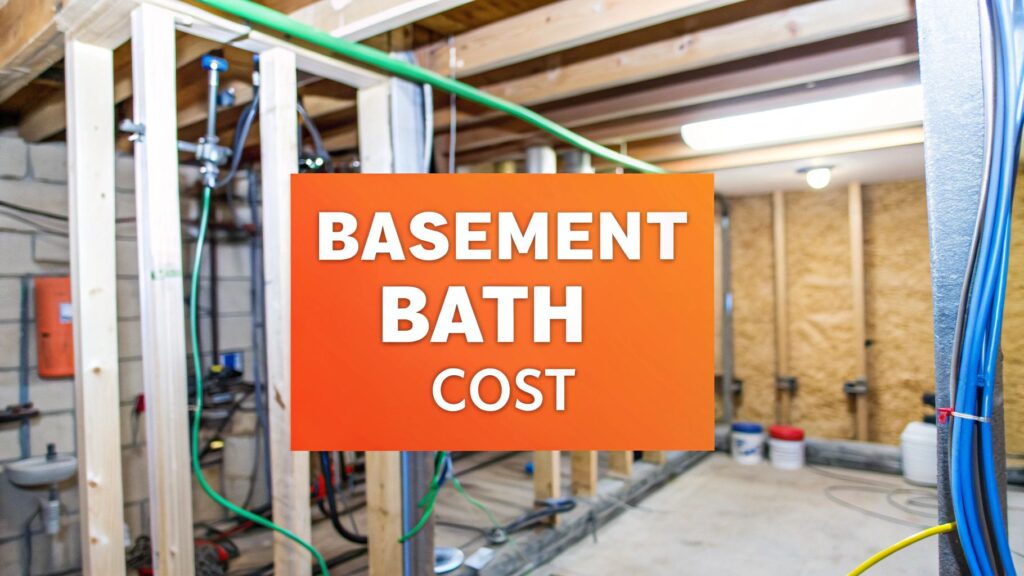Thinking about turning that underused basement into a truly functional living area? Adding a bathroom is often the first step, but the big question is always the same: what’s it going to cost? For homeowners in Orange County, you can expect the cost to install a bathroom in the basement to range anywhere from $8,000 to over $25,000. The final number really depends on the complexity of the plumbing required and the quality of finishes you choose.
Your Guide to Basement Bathroom Installation Costs
Planning a basement bathroom addition here in Orange County begins with a solid understanding of the budget. This guide is designed to pull back the curtain on every cost, from the hidden-but-critical plumbing and electrical work to the stylish finishes that make the space your own. Our goal is simple: replace uncertainty with confidence, so you can make smart, informed decisions for your home.
As a BBB Torch Award Winner for Ethics and a licensed General Contractor, Sparkle Restoration Services is built on a foundation of transparency. We believe a well-informed client is a happy client, and that starts with a crystal-clear financial picture from day one.
Understanding the Budget Breakdown
Your total investment is a mix of several key components, each with its own price tag. The two biggest slices of the pie are almost always the mechanical systems (plumbing and electrical) and the materials you select for the finishes.
- Mechanical Systems: This is the critical work behind the walls. It includes running new drain lines, installing proper ventilation (an absolute must for basement health), and wiring for lights, fans, and outlets.
- Finishes and Fixtures: This is where your vision comes to life. We’re talking about the tile, vanity, faucets, lighting, and paint that define the look and feel of your new bathroom.
- Permits and Labor: These are the non-negotiable costs that cover city approvals and the skilled, certified professionals needed to build a bathroom that’s safe, up-to-code, and built to last.
This infographic gives you a great visual of how a typical basement bathroom budget gets divided up.
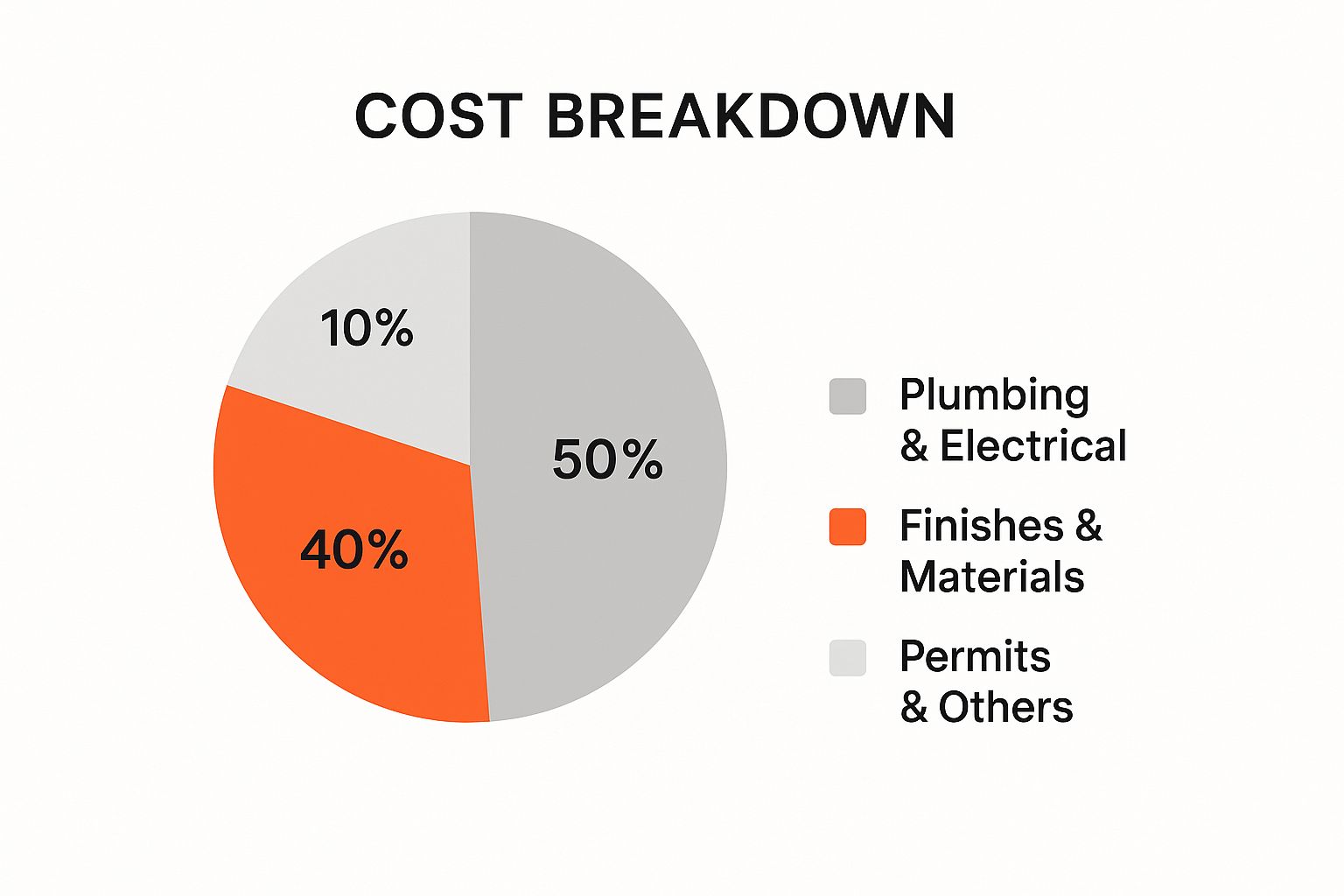
As you can see, plumbing and electrical work often take up the biggest chunk of the budget. This really underscores the technical challenges of adding a bathroom below ground level.
Typical Cost Ranges in 2025
Let’s put some real numbers to this. To give you a clearer idea of where your project might land, we’ve broken down the costs into three common tiers.
Basement Bathroom Cost At a Glance by Project Tier
| Project Tier | Average Cost Range | Key Features |
|---|---|---|
| Basic/Budget | $8,000 – $15,000 | Standard fixtures, vinyl or basic tile flooring, pre-fab shower stall, basic vanity and lighting. |
| Mid-Range | $15,000 – $20,000 | Upgraded fixtures, quality tile work, semi-custom vanity, improved lighting, and better ventilation. |
| High-End/Luxury | $25,000+ | Custom cabinetry, high-end fixtures (like rain shower heads), heated floors, custom tile designs, and premium lighting. |
A huge variable here is the plumbing, which on its own can run from $2,000 to $10,000. If your basement needs a special sewage ejector pump to fight gravity, that will push the cost toward the higher end of the range.
A successful basement renovation is built on a solid plan. Understanding the complete financial picture from the start prevents costly surprises and ensures the final result aligns perfectly with your expectations and your home’s value.
To get an even deeper understanding of where your money goes, digging into a detailed bathroom remodel cost breakdown can shed light on material costs, labor rates, and other potential expenses. Working with an experienced team that provides comprehensive design-build services is the best way to make sure every detail is accounted for, from the first sketch to the final walkthrough.
Breaking Down Costs by Square Foot and Component
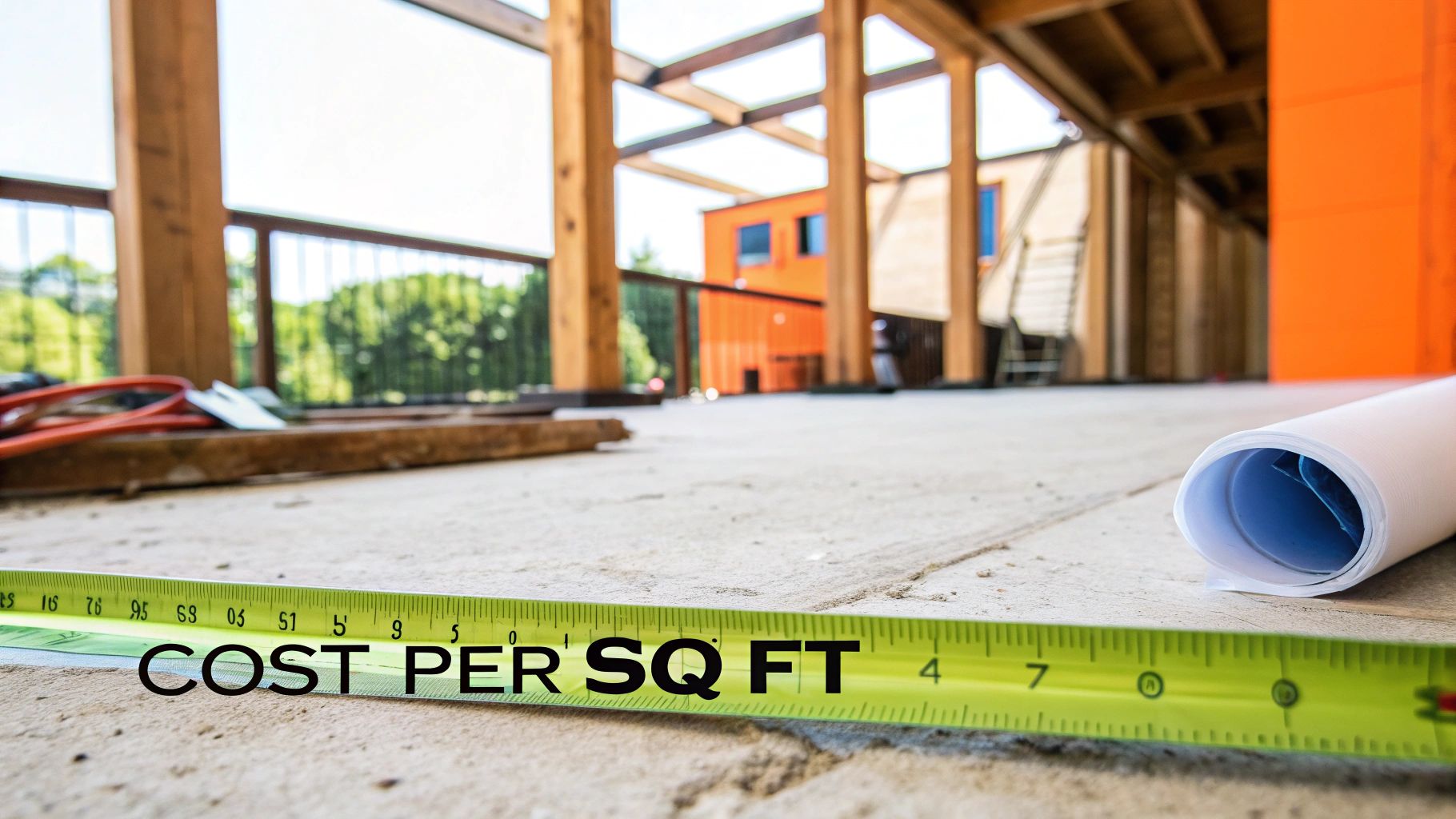
To put together a realistic budget, you’re going to need more than just a ballpark figure. Diving into the details of the cost to install a bathroom in the basement on a per-square-foot basis gives you a much clearer picture of what to expect. This is true whether you’re planning a tiny half-bath or a sprawling, spa-like escape.
Thinking in terms of square footage is incredibly useful because it directly connects the size of your project to the bottom line. It makes it easy to see how a larger footprint demands more materials and labor—two of the biggest cost drivers here in Southern California.
Cost Per Square Foot Analysis
For most homeowners in Orange County, the cost per square foot for a new basement bathroom typically lands somewhere between $200 and $250. This range accounts for the unique challenges that come with any below-grade construction, like specialized plumbing, serious moisture-proofing, and proper ventilation.
Let’s put that into perspective. A standard 40-square-foot half-bath might run you somewhere in the $8,000 to $10,000 range. If you’re dreaming bigger, a more spacious 80-square-foot full bathroom with a shower could easily climb to $16,000 to $20,000 or more, and that’s before you even start thinking about luxury finishes.
Understanding the cost per square foot empowers you during the planning phase. It transforms abstract budget numbers into tangible spatial decisions, helping you balance your desired layout with your financial investment.
Recent industry data helps add more context. A basic installation in a space from 15 to 50 square feet could range anywhere from $3,000 to $12,500, with the final number depending heavily on your fixture choices. On the other hand, if this bathroom is part of a full basement remodel, that broader project can average $25 to $65 per square foot, often totaling $12,500 to $37,500 for everything.
Itemizing Individual Components
Looking beyond the overall square footage, it’s just as important to understand how each individual piece contributes to the final cost. Every choice you make, from the shower to the sink, has its own price tag for both the product and the skilled labor needed to install it. This is where your vision really takes shape—and where the budget gets real.
To give you a clearer idea of where your money goes, we’ve broken down the typical costs for the key fixtures and services in a basement bathroom project.
Estimated Cost Breakdown by Individual Component
| Component/Service | Typical Cost Range | Influencing Factors |
|---|---|---|
| Shower Installation | $1,000 – $15,000+ | Prefab stall vs. custom tile, frameless glass doors, complex plumbing |
| Vanity and Sink | $580 – $2,000+ | Basic combo unit vs. high-end custom vanity, dual sinks, premium faucets |
| Toilet | $300 – $800 | Standard models vs. high-efficiency or smart toilets |
| Flooring | $220 – $2,500 | Material choice (LVT, porcelain, natural stone), complexity of the layout |
| Ventilation Fan | $400 – $900 | Fan quality (CFM rating, noise level), complexity of ductwork installation |
As you can see, the choices you make have a massive impact. This is where having an experienced contractor in your corner makes all the difference.
As a licensed general contractor specializing in high-end renovations, we help our clients navigate these decisions to find the perfect balance of style, function, and budget. Our deep experience in luxury remodeling and construction means we can source the best materials and provide expert installation for a flawless finish that truly lasts.
Getting into the Guts: Core Plumbing and Electrical Work
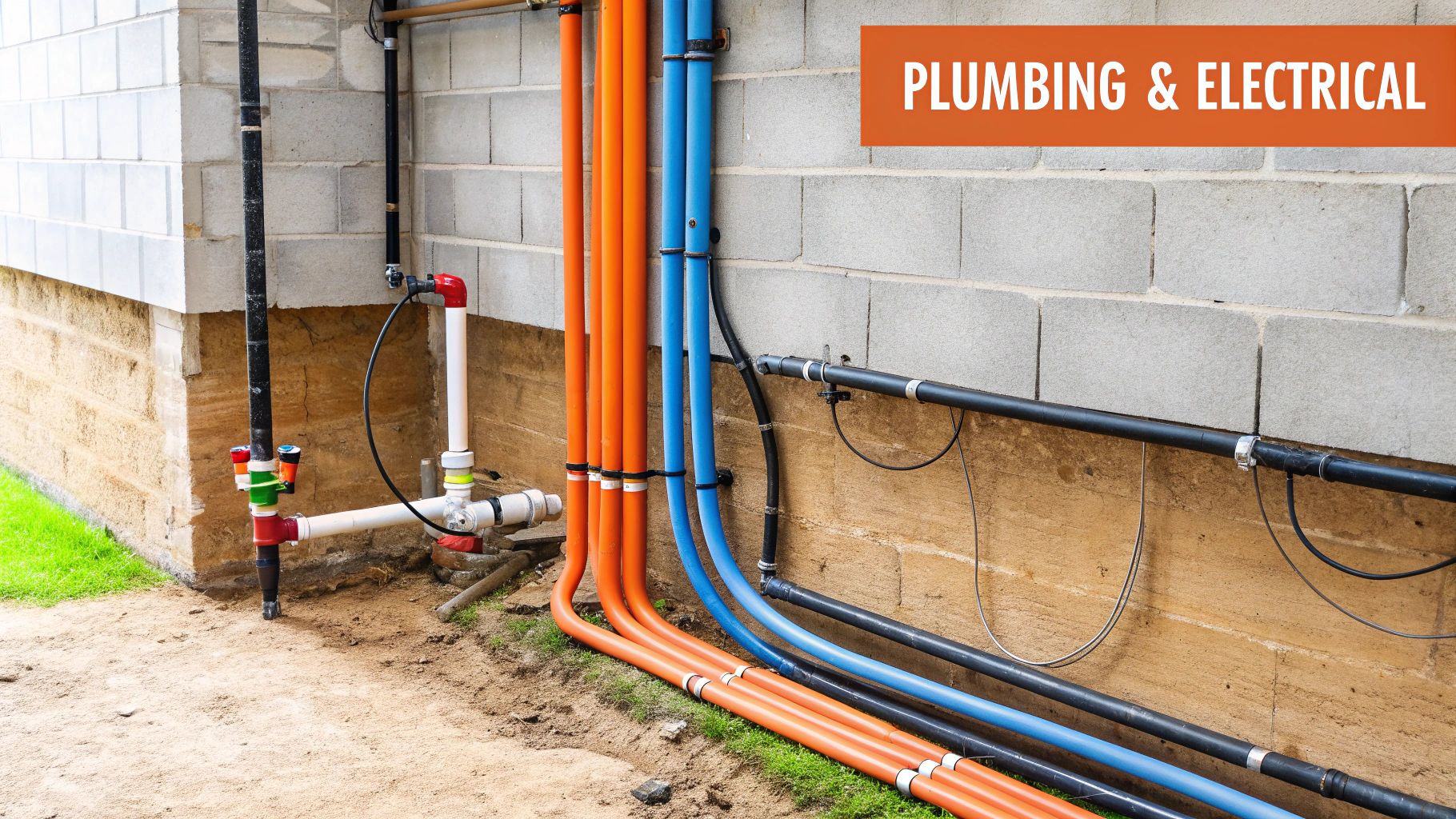
While picking out tiles and vanities is exciting, the real make-or-break work happens behind the drywall. The plumbing and electrical systems are the heart of your new bathroom, and a massive chunk of the cost to install a bathroom in the basement goes right here.
Getting these systems right is non-negotiable. It’s about safety, function, and adhering to strict Orange County building codes. This is where the unique challenge of a basement project really shows up. You’re not just tapping into existing lines; you’re often working against gravity in a space that was never designed to have a bathroom.
The Challenge of Below-Grade Plumbing
Imagine your home’s main drain line is a river flowing gently downhill, carrying everything away. A basement, by its very nature, is below the waterline of that river. This is the single biggest hurdle for basement plumbing, and it drives a significant portion of the cost.
To get waste up and out, you need a pump. That almost always means breaking up the concrete floor to install new plumbing.
- Up-Flush Toilet Systems: These are a less invasive option. A macerating pump sits behind the toilet, grinds up waste, and pumps it up to the main drain. They’re simpler to install but can be noisy and might not be the best choice for a high-traffic bathroom.
- Sewage Ejector Pumps: This is the heavy-duty, preferred solution for most projects. We install a sealed basin into the concrete floor to collect waste from the toilet, sink, and shower. Once it’s full, a powerful pump automatically kicks on and sends everything up to the main sewer line.
Installing a sewage ejector pump isn’t a weekend DIY job. It takes precision jackhammering, expert plumbing, and a perfect seal to prevent leaks or odors down the road. This is exactly why you want a licensed, experienced contractor handling this critical work.
Powering Your New Space Safely
Electrical work in any bathroom is all about safety, but even more so in a basement where moisture can be a bigger issue. This isn’t just about making the lights turn on; it’s about protecting your home and family. The job has to be planned and executed perfectly to meet strict codes.
Adding new lights, a powerful fan, and outlets puts a new strain on your home’s electrical panel. A qualified electrician will first ensure your system can handle the extra demand without constantly tripping breakers. If you’re curious about the details, learning about calculating electrical load is a great way to understand this crucial safety check.
Here are a few must-haves for basement bathroom wiring:
- GFCI Outlets: Ground Fault Circuit Interrupter outlets are required by code anywhere near water. They’re lifesavers, designed to instantly cut power if they sense a short, preventing a dangerous shock.
- Dedicated Circuits: Anything that draws significant power, like a strong vent fan or a heated floor, will likely need its own circuit straight from the panel.
- Proper Lighting and Ventilation Wiring: You need good lighting at the vanity and in the main space, plus a ventilation fan that is wired correctly and vented all the way to the outside of your home.
The technical skills needed for both plumbing and electrical really highlight the value of having a professional in charge. As an IICRC Master Certified firm and licensed General Contractor, Sparkle Restoration Services handles these details every day. We ensure every pipe is sealed tight, every wire is safe, and your project is 100% compliant with local Newport Beach and Irvine codes. For more on this, check out our guide on hiring the right contractor for your bathroom remodel.
How Finishes and Materials Shape Your Final Budget
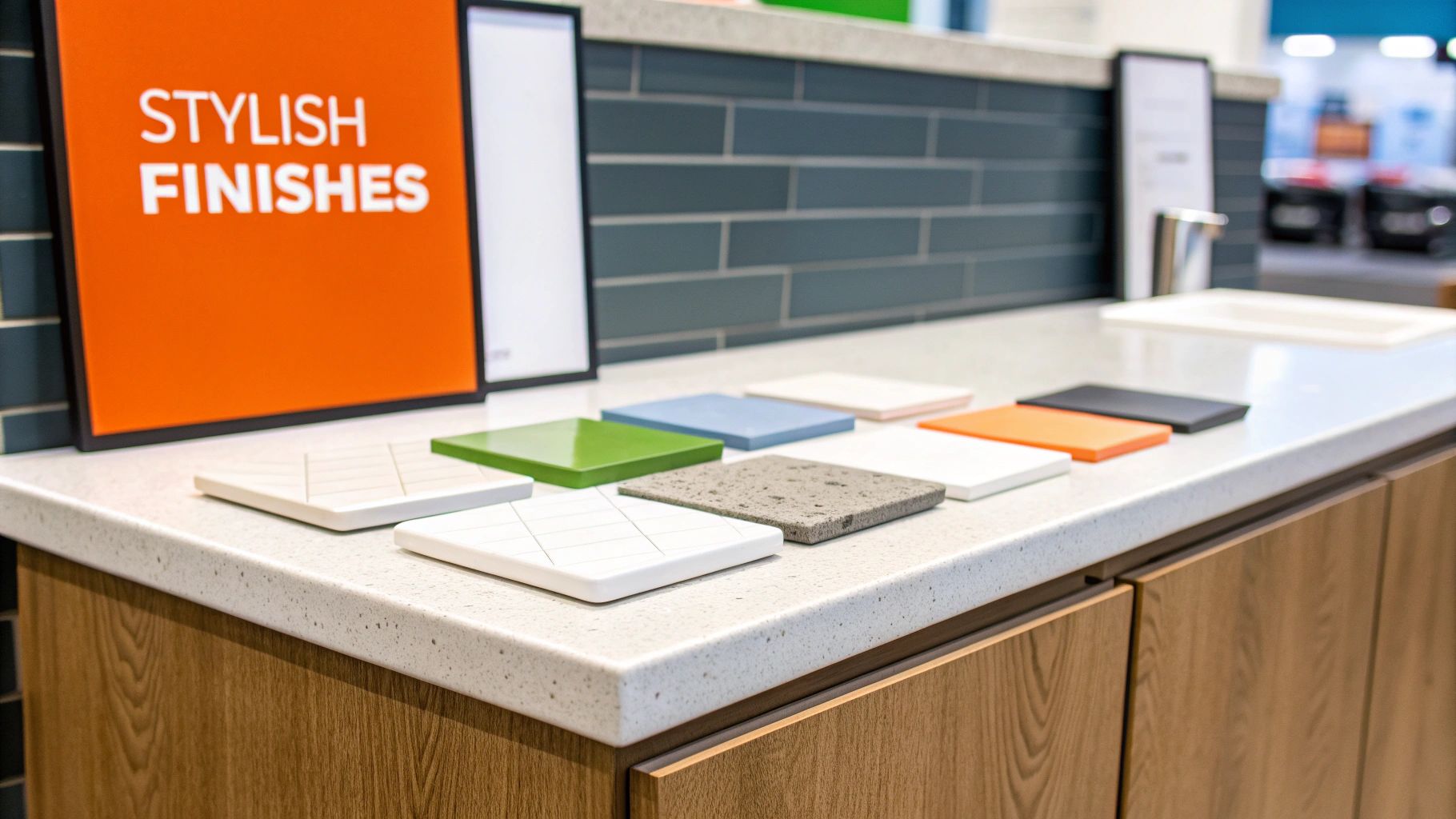
While the heavy lifting of plumbing and electrical work forms the backbone of your project, it’s the finishes and materials that truly bring your new bathroom to life. This is where the personality of the space takes shape, and it’s also where the cost to install a bathroom in the basement can see its biggest swings.
Your choices here are what make the difference between a simple, functional bathroom and a luxurious, spa-like retreat. As your design-build partner, our job is to help you navigate these selections so the final result perfectly matches your style and your budget.
Flooring: The Foundation of Your Design
Flooring is one of the first big decisions you’ll make, and in a basement, it’s about more than just looks. You need something that can stand up to the unique challenges of a below-grade environment, namely moisture.
- Luxury Vinyl Tile (LVT) & Luxury Vinyl Plank (LVP): There’s a reason LVT and LVP are so popular for basements. They are 100% waterproof, incredibly durable, and come in a huge range of styles that do an amazing job of mimicking real wood or stone. It’s a fantastic way to get a high-end look without the high-end maintenance.
- Porcelain & Ceramic Tile: Tile is a classic for a reason. You just can’t beat its durability and water resistance. While the material and labor costs can be higher, it delivers a timeless, premium feel that many Orange County homeowners are looking for.
Getting the flooring right sets the tone for the entire room. At Sparkle, we walk you through all the options to make sure your basement bathroom is built on a beautiful, durable foundation. For a closer look at materials, check out our guide to flooring sales and installation.
Vanities and Fixtures: The Centerpieces of Style
The vanity, faucet, showerhead, and toilet are the workhorses of the bathroom, but their costs can vary wildly. This is where you can really make a strategic impact with your budget.
A perfect example of a budget-defining decision is the choice between a pre-fabricated vanity from a big-box store and a custom-built piece. The stock unit is fast and affordable, while custom cabinetry gives you a perfect fit and a bespoke look that elevates the whole room.
Think of fixtures like the jewelry of the bathroom. A standard chrome faucet is perfectly functional and easy on the wallet. But upgrading to a modern matte black or a warm brushed gold finish can instantly add a dose of luxury. The same goes for the shower—a basic head gets the job done, but a rainfall shower system can turn your daily routine into a spa experience.
Lighting and Ventilation: Function Meets Ambiance
Good lighting is non-negotiable in a basement bathroom, which usually doesn’t get much natural light. A smart lighting plan can make the space feel bigger, brighter, and way more inviting.
- Task Lighting: This is your essential, functional light at the vanity. Sconces placed on either side of a mirror often provide more flattering light than a single fixture overhead.
- Ambient Lighting: Recessed ceiling lights (or can lights) are great for providing bright, overall illumination without cluttering up the ceiling.
- Accent Lighting: Want to add a little flair? A small chandelier or a stylish pendant light can introduce a decorative touch and an extra layer of sophistication.
Proper ventilation is just as critical. A high-quality, quiet exhaust fan is not the place to cut corners. It’s absolutely essential for managing moisture, preventing mold, and protecting your entire investment. As IICRC Master Certified restoration experts, this is a principle we live by. We make sure your fan isn’t just installed—it’s properly ducted all the way to the exterior to ensure it works effectively for years to come.
The Hidden Costs: Permits, Framing, and Ventilation
It’s easy to get caught up in picking out tile and faucets—the exciting parts of a remodel. But what really makes or breaks a basement bathroom project are the things you don’t see. We’re talking about the skeleton of the room: the permits, the framing, and the system that keeps it all dry and healthy.
These are the non-negotiable, behind-the-scenes costs. As a licensed General Contractor and a BBB Torch Awards for Ethics Winner, we make it a point to walk homeowners through these expenses. A solid budget has no surprises, and a solid bathroom is built right from the ground up.
First Things First: Building Permits
Before any work begins, you have to get the green light from your city. A building permit is your official permission, and for a project involving new plumbing and electrical, it’s an absolute must. For anyone in Orange County, from Newport Beach to Irvine, this is how you ensure the work meets all local safety and building codes.
Expect to spend anywhere from $500 to $2,000 for a permit. That fee covers the city’s review of your plans and the inspections they’ll perform at different stages. It might feel like just another line item, but a properly permitted project is your best insurance policy. It protects your home’s value and guarantees everything is done to a professional standard.
Framing, Drywall, and a Watertight Seal
Once the concrete has been broken up (and put back together) for the new plumbing lines, the bathroom starts to take a recognizable shape. This is where we build the walls and make sure everything is completely protected from moisture.
- Framing: This is the lumber that creates the walls and outlines your bathroom layout. Depending on the size of the space, framing materials and labor will typically run between $1,000 and $2,500.
- Moisture-Resistant Drywall: Regular drywall in a basement is a recipe for disaster; it acts like a sponge. We only use moisture-resistant products like “green board” or “purple board,” which are specifically made to fight off humidity and stop mold before it can start.
- Waterproofing: This is arguably the single most important step for a bathroom below ground. We apply a thick, liquid waterproofing membrane over the shower walls before a single tile goes up. This creates a seamless barrier that keeps water from ever touching the framing.
Neglecting proper waterproofing is one of the costliest mistakes a homeowner can make. As IICRC Master Certified water damage experts, we’ve seen firsthand how a small leak can lead to catastrophic mold and structural issues. Investing in a robust waterproofing system is non-negotiable for a healthy, durable basement.
Why You Can’t Skimp on Ventilation
Basements are naturally damp, and a bathroom adds a ton of steam and moisture into that environment. Without a way to get that humid air out, you’re just asking for musty smells, peeling paint, and eventually, mold. A good exhaust fan isn’t a luxury here—it’s essential.
The trick is to get a fan that’s powerful enough for the square footage and—this is crucial—is vented all the way to the outside of your house. Venting it into the space between ceiling joists just shuffles the problem to a different part of the basement. A properly installed fan and all the necessary ductwork will usually cost between $500 and $1,200. It’s a small price to pay for healthy air and protecting the rest of your basement from moisture damage.
Realizing the Return on Your Investment
Looking at the cost to install a bathroom in the basement as just another expense misses the bigger picture entirely. This is a strategic investment that pays you back in both lifestyle and property value. Especially in competitive Orange County real estate markets like Newport Beach and Irvine, a finished basement with a full bathroom is a knockout feature that grabs a buyer’s attention and justifies a higher asking price.
This single addition completely changes how your home functions. What was once a forgotten storage space is suddenly transformed into one of its most desirable features, unlocking a host of new possibilities.
From Unused Space to Valuable Asset
Let’s explore your basement’s potential for a moment. By adding a bathroom, you’re laying the foundation for all sorts of high-value uses that directly make your home more functional and appealing.
- A Private Guest Suite: Give visiting family and friends a comfortable, private space that feels more like a boutique hotel room than a spare bedroom.
- The Ultimate Entertainment Hub: A basement bathroom is non-negotiable for a home theater, game room, or wet bar. It gives guests total convenience without them having to trek upstairs.
- Serious Income Potential: In many areas, a basement complete with a bathroom can be legally converted into a rental unit or ADU, creating a brand-new revenue stream.
Fresh industry reports show the average price for a full basement remodel hovers around $22,800. The bathroom addition itself typically accounts for $6,600 to $16,500 of that total. This investment provides a massive boost to a home’s functional value, particularly in markets where people are actively looking for homes with guest suites or potential rental units.
Calculating the Long-Term Value
The true value of adding a basement bathroom goes way beyond the initial checks you write. This project significantly bumps up your home’s usable square footage, a critical metric in any property valuation. Even more importantly, it creates a more livable, versatile home that can adapt to your family’s needs as they change over the years.
A well-executed basement bathroom isn’t just a project; it’s an upgrade to your entire lifestyle. It delivers immediate daily benefits while building long-term equity, making it one of the smartest investments a homeowner can make.
As a licensed General Contractor specializing in luxury remodels, we at Sparkle Restoration Services see this project as one of the most powerful tools for boosting a home’s worth. Our focus is on building lasting value, making sure the investment you make today pays you back with significant financial and personal returns for years. To dig deeper into how a new bathroom can affect your home’s bottom line, check out our guide on bathroom remodel return on investment.
Basement Bathroom FAQs
When you’re planning to add a bathroom to your basement here in Orange County, a lot of the same questions tend to pop up. To give you a clear picture, we’ve pulled together the most common questions we hear and answered them in a straightforward, no-nonsense way. Our goal is to give you the confidence to move forward.
How Long Does a Basement Bathroom Installation Take?
From the first day of construction to the final walkthrough, you can generally expect a basement bathroom project to take anywhere from 3 to 6 weeks. Of course, that timeline can shift based on a few key factors.
- Project Complexity: A simple powder room is a much quicker job than a full-blown luxury bathroom that needs complex plumbing rerouting and intricate custom tile.
- Permit and Inspection Schedules: We are all on the city’s schedule. Necessary inspections in places like Irvine or Newport Beach are milestones that can stretch or shorten the timeline.
- Material Availability: If you have your heart set on a custom-ordered vanity or special-order tiles, their lead times will need to be baked into the project schedule from day one.
An experienced design-build firm like Sparkle Restoration Services manages all these moving parts, building a detailed schedule designed to preempt delays before they happen.
Do I Really Need a Permit for This?
Yes, a building permit is absolutely non-negotiable for a new basement bathroom. Any time you’re adding new plumbing, running new electrical wires, or making structural changes, you need official approval and inspections. Trying to skip this step is a recipe for disaster—you could face hefty fines, major headaches when you try to sell your home, and even serious safety risks.
“A permit isn’t just a piece of paper; it’s your guarantee that the work is being done correctly and safely, according to all local building codes. It’s about protecting your family, your investment, and your home’s long-term value.”
As your licensed General Contractor, we handle the entire permitting process from start to finish. This ensures every single part of your project is 100% compliant and built to last.
Can a Bathroom Be Added to Any Basement?
While most basements are good candidates for a bathroom, there are a few things we need to evaluate first. Headroom is a big one; building codes require a certain minimum ceiling height. We also have to take a close look at your existing plumbing and electrical systems to figure out the smartest, most cost-effective way to tie into them for the new bathroom.
Our first consultation always includes a deep dive into your basement’s specific layout and infrastructure. This lets us spot any potential roadblocks right away and design a bathroom that not only looks great but also works perfectly within the space you have.
Ready to transform your basement with a beautiful, functional new bathroom? The experts at Sparkle Restoration Services are here to guide you through every step, from initial design to final polish. Schedule your free, no-obligation consultation today and let us turn your vision into a valuable reality.

